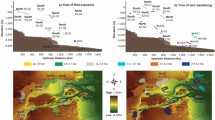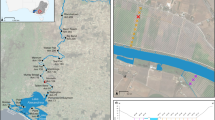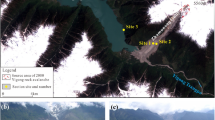Abstract
Alluvial scour into shallow marine sediments may be caused by the incision of a river adjusting to a new base level1–4 following a fall in sea level. The identification of such erosion surfaces1–3 has therefore been pivotal in the reconstruction of past sea-level changes from ancient sedimentary sequences1–14. Here we report data from a study of the Jamuna river, Bangladesh, one of the world's largest modern braided rivers15, which illustrate that bed scour associated with channel confluences and bends alone can be substantial—as much as five times greater than the mean channel depth. Indeed, the basal erosion surfaces produced by such deep scours have characteristics similar to those of boundaries in some ancient sedimentary sequences that have been assumed to result from sea-level fall1–14, potentially leading to radically different interpretations of past variation in base level and climate. We suggest that, to discount unambiguously the influence of fluvial scour in ancient sediments, the erosive boundary should be greater than five times the mean channel depth and extend for distances greater than the floodplain width. Ideally, it should be traceable between different basins.
This is a preview of subscription content, access via your institution
Access options
Subscribe to this journal
Receive 51 print issues and online access
$199.00 per year
only $3.90 per issue
Buy this article
- Purchase on Springer Link
- Instant access to full article PDF
Prices may be subject to local taxes which are calculated during checkout
Similar content being viewed by others
References
Postmentier, H. W., Jervey, M. T. & Vail, P. R. Eustatic controls on clastic deposition I-conceptual framework. Soc. Econ. Paleontol. Mineral Spec. Publ. 42, 109–124 (1988).
Postmentier, H. W. & Vail, P. R. Eustatic controls on clastic deposition II—Sequence and systems tract models. Soc. Econ. Paleontol. Mineral. Spec. Publ. 42, 125–154 (1988).
Van Wagoner, J. C., Mitchum, R. M., Campion, K. M. & Rahmanian, V. D. Siliciclastic sequence stratigraphy in well logs, cores and outcrops: concepts for high resolution correlation of time and facies. Am. Assoc. Petrol. Geol. Methods in Exploration 7, (1990).
Dalrymple, R. W., Boyd, R. & Zaitlin, B. A. (eds) Incised-Valley Systems: Origin and Sedimentary Sequences. Soc. Econ. Paleontol. Mineral. Spec. Publ. 51, (1994).
Hampson, G. J., Elliott, T. & Flint, S. S. Critical application of high resolution sequence stratigraphic concepts to the Rough Rock Group (Upper Carboniferous) of northern England. Geol. Soc. London Spec. Publ. 104, 221–246 (1996).
Aitken, J. F. & Flint, S. S. The application of high-resolution sequence stratigraphy to fluvial systems: a case study from the Upper Carboniferous Breathitt Group, eastern Kentucky, USA. Sedimentology 42, 3—30 (1995).
Flint, S., Aitken, J. & Hampson, G. Application of sequence stratigraphy to coal-bearing coastal plain successions: implications for the UK Coal Measures. Geol. Soc. London Spec. Publ. 82, 1–16 (1995).
Davies, S. J. & Elliott, T. Spectral gamma ray characterization of high resolution sequence stratigraphy: examples from Upper Carboniferous fluvio-deltaic systems, County Clare, Ireland. Geol. Soc. London Spec. Publ. 104, 25–35 (1996).
Hampson, G. Discrimination of regionally extensive coals in the Upper Carboniferous of the Pennine Basin, UK, using high resolution sequence stratigraphic concepts. Geol. Soc. London. Spec. Publ. 82, 79–97 (1995).
Aitken, J. F. & Flint, S. S. Variable expressions of interfluvial sequence boundaries in the Breathitt Group (Pennsylvanian), eastern Kentucky, USA. Geol. Soc. London Spec. Publ. 104, 193–206 (1996).
Shanley, K. W. & McCabe, P. J. Perspectives on the sequence stratigraphy of continental strata. Am. Assoc. Petrol. Geol. Bull. 78, 544–568 (1994).
Leckie, D., Fox, C. & Tarnocai, C. Multiple paleosols of the late Albian Boulder Creek Formation, British Columbia, Canada. Sedimentology 36, 307–322 (1989).
Leeder, M. R. & Stewart, M. D. Fluvial incision and sequence stratigraphy: alluvial responses to relative sea-level fall and their detection in the geological record. Geol. Soc. London Spec. Publ. 103, 25–39 (1996).
Leckie, D. A. Canterbury Plains, New Zealand—implications for sequence stratigraphic models. Am. Assoc. Petrol. Geol. Bull. 78, 1240–1256 (1994).
Schumm, S. A. & Winkley, B. A. in The Variability of Large Alluvial Rivers 1–9 (Am. Soc. Civ. Engrs., New York, 1994).
Salter, T. Fluvial scour and incision: models for their influence on the development of realistic reservoir geometries. Geol. Soc. London Spec. Publ. 73, 33–51 (1993).
River Survey Project Flood Action Plan 24 Final Report for Flood Plan Coordinating Committee (Delft Hydraulics/Danish Hydraulics Institute/Hydroland/Approtech/Osiris, Dhaka, 1996).
Klaassen, G. J. & Vermeer, K. Confluence scour in large braided rivers with fine bed material. Proc. Int. Conf. Fluvial Hydraulics, 395–408 (Vituki, Budapest, 1988).
Lindsay, J. F., Holliday, D. W. & Hulbert, A. G. Sequence stratigraphy and the evolution of the Ganges-Brahmaputra delta complex. Am. Assoc. Petrol. Geol. Bull. 75, 1233–1254 (1991).
Umitsu, M. Late Quaternary sedimentary environments and landforms in the Ganges delta. Sedim. Geol. 83, 177–186 (1993).
Ashmore, P. E. & Parker, G. Confluence scour in coarse braided streams. Wat. Resour. Res. 19, 392–402 (1983).
Best, J. L. Sediment transport and bed morphology at river channel confluences. Sedimentology 35, 481–498 (1988).
Klaassen, G. J., Mosselman, E. & Br¨hl, H. On the prediction of planform changes in braided sand-bed rivers. Proc. Int. Conf. Hydrosci. Engng. 134–146 (Centre for Comp. Hydroscience and Engng, Mississippi, 1993).
Barua, D. K. On the environmental controls of Bangladesh river systems. Asia Pacif. J. Envir. Dev. 1, 81–98 (1994).
Thorne, C. R., Russell, A. P. G. & Alam, M. K. Planform pattern and channel evolution of the Brahmaputra River, Bangladesh. Geol. Soc. London Spec. Publ. 75, 257–276 (1993).
Winkley, B. R., Lesleighter, E. J. & Cooney, J. R. in The Variability of Large Alluvial Rivers 269–284 (Am. Soc. Civ. Engrs., New York, 1994).
Murray, A. B. & Paola, C. A cellular model of braided rivers. Nature 371, 54–57 (1994).
Peters, J. J. Morphological studies and data needs. Proc. Int. Workshop on Morphological Behaviour of Major Rivers in Bangladesh (Dhaka, 1993).
Author information
Authors and Affiliations
Rights and permissions
About this article
Cite this article
Best, J., Ashworth, P. Scour in large braided rivers and the recognition of sequence stratigraphic boundaries. Nature 387, 275–277 (1997). https://doi.org/10.1038/387275a0
Received:
Accepted:
Issue Date:
DOI: https://doi.org/10.1038/387275a0
This article is cited by
-
River dynamics – a geospatial analysis of Jamuna (Brahmaputra) River in Bangladesh during 1973–2019 using Landsat satellite remote sensing data and GIS
Environmental Monitoring and Assessment (2023)
-
Geomorphological processes and their connectivity in hillslope, fluvial, and coastal areas in Bangladesh: A review
Progress in Earth and Planetary Science (2022)
-
The dynamics of river confluences and their effects on the ecology of aquatic environment: A review
Journal of Hydrodynamics (2022)
-
Assessing the long-term planform dynamics of Ganges–Jamuna confluence with the aid of remote sensing and GIS
Natural Hazards (2022)
-
Formation of undulating topography and gravel beds at the bases of incised valleys: Last Glacial Maximum examples beneath the lowlands facing Tokyo Bay
Progress in Earth and Planetary Science (2021)
Comments
By submitting a comment you agree to abide by our Terms and Community Guidelines. If you find something abusive or that does not comply with our terms or guidelines please flag it as inappropriate.



